How Astronauts Train Their Lungs for Space Travel
The ride that makes astronauts sick
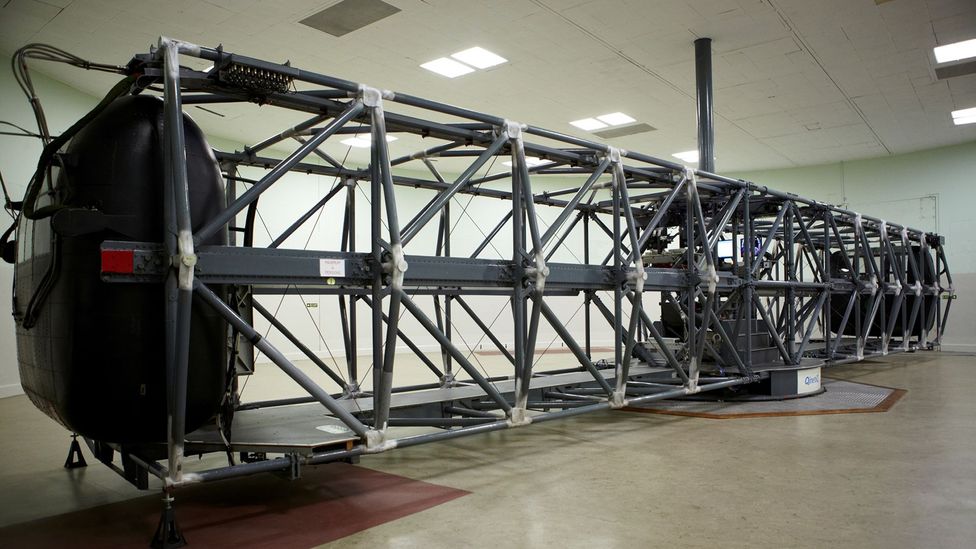
Want to train for infinite or the rigours of modernistic military flight? You might have to climb into a 60-year-sometime centrifuge all the same putting pilots through their paces.
D
During ane of the few memorable sequences in the critically mauled 2002 movie Time Machine, our hero (Guy Pearce) travels into the future and we meet the world modify around him. Cars replace carriages, mechanical becomes electronic, a new city rises, just Pearce remains insulated within the bubble of his Victorian time car.
The same thing has happened to the sixty-year-onetime homo centrifuge at Farnborough in southern England. Once office of a military facility, then enclosed within an industrial manor, today it is surrounded by a modern housing complex. But compare the three-storey-loftier circular brick edifice with pictures from the day it was first opened in 1955, and it looks exactly the same.
This weird out-of-time feeling continues when yous enter the reception area – a bare room containing an immaculate 1950s desk – or climb the physical stairs to the briefing room, where 50s stackable metal chairs surround a long wooden table. Even the walls have a curiously sometime-fashioned Ovaltiney hue to them.
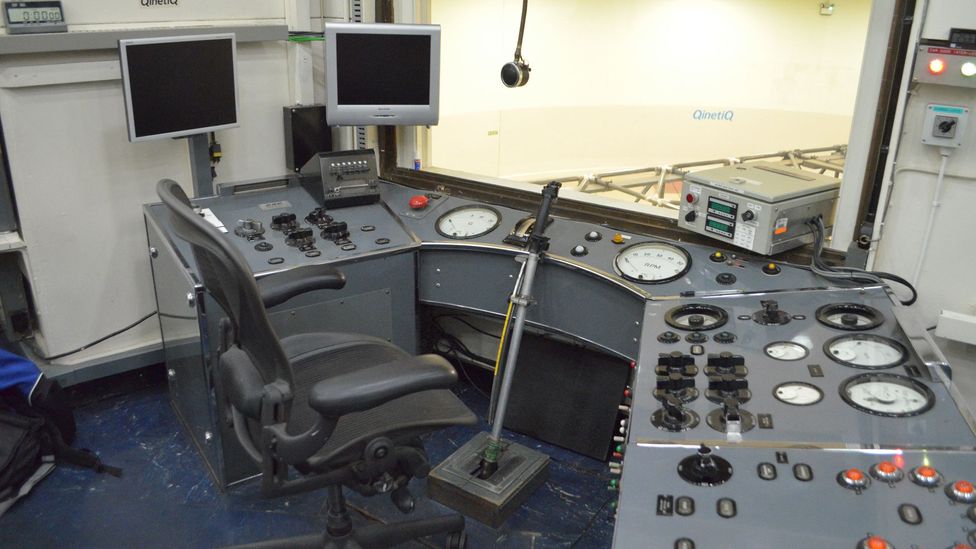
The control room has a decidedly 1950s look thank you to the retro console (Credit: John Watkins)
However, the man sitting at the tabular array is clearly from the futurity.
Dressed in a dark greenish single-slice survival accommodate, zipped up to his neck with wires and tubes attached to his legs and breast, Ed Martin looks every bit the aviator of tomorrow. The Right Stuff demeanour is macerated somewhat by long beads of sweat dripping downwards his face up – the unfortunate event of wearing the latest air force winter gear in an overheated room in late summer.
Martin is a volunteer, kitted-out to examination paradigm anti-G trousers. Issued to aircrews, these are linked to shipping avionics to inflate during high dispatch manoeuvres – forcing blood abroad from the legs towards the brain to preclude pilots from blacking out.
In employ for decades, these outfits are essential in modernistic fighter aircraft, such every bit United kingdom'southward Typhoon, and will about certainly need to be used in the space and rocket planes of the future.
"The anti-g trousers inflate to push button the claret dorsum up into the chest," says Des Connolly, the medical dr. overseeing today's study. "So instead of the blood beingness pushed towards the legs, blood pressure is maintained to assistance force blood up to the head."

This video is no longer bachelor
The particular pair of trousers Martin is wearing use new materials, although for obvious security and commercial reasons no one at QinetiQ – the defense and infinite company that runs the facility – is going to tell me exactly what is innovative about them. They will, however, let me watch as they discipline the legwear – with Martin inside them – to a terrifying experiment.
"I'll be spun circular at 9G – that'south 9 times the force of gravity, increasing my body weight nine times," Martin explains, as he is strapped tightly into a five-point harness. His seat – an ejector seat from a Tornado aircraft – is enclosed within a battered ovoid gondola swinging from the terminate of a sixty-foot diameter metal lattice arm.
"I've washed information technology quite a few times – information technology's quite enjoyable," says Martin, as I wait at him with disbelief.
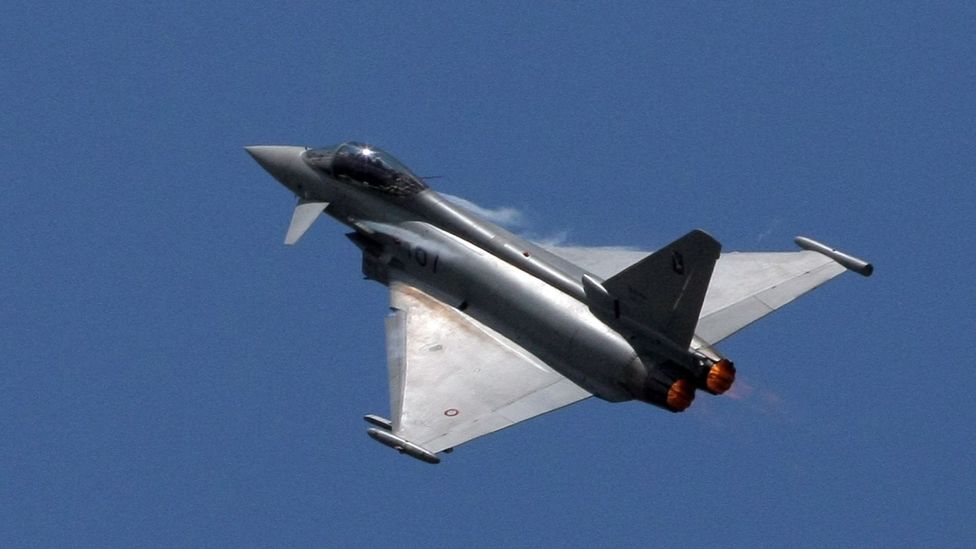
Pilots flying the RAF Typhoon are put through their paces in the centrifuge first (Credit: Getty Images)
The centrifuge arm sits at the base of operations of a loftier circular bedroom, below it a massive direct-drive electric motor capable of generating accelerations that – without the anti-thousand trousers – would crusade about normal people to lose consciousness.
Retro computer
With Martin strapped in and connected up to centre and breathing monitors and his adapt hooked up to the air supply, the experiment is ready to brainstorm. The main sleeping room lights are switched off, leaving the gondola seemingly suspended in space. A technician closes the heavy steel door on the centrifuge hall and winds a wheel to secure it shut.
Up in the control room, overlooking the bedchamber, the calculator whirrs into action. This motorcar too celebrates its 60th ceremony this yr. Full of gears, belts and shafts, the rare mechanical computer resembles a grey chest freezer. The program is a flat snail-shaped disc, known as a cam. Each cam is effectually the size of a vinyl record (and its shape determines the acceleration).
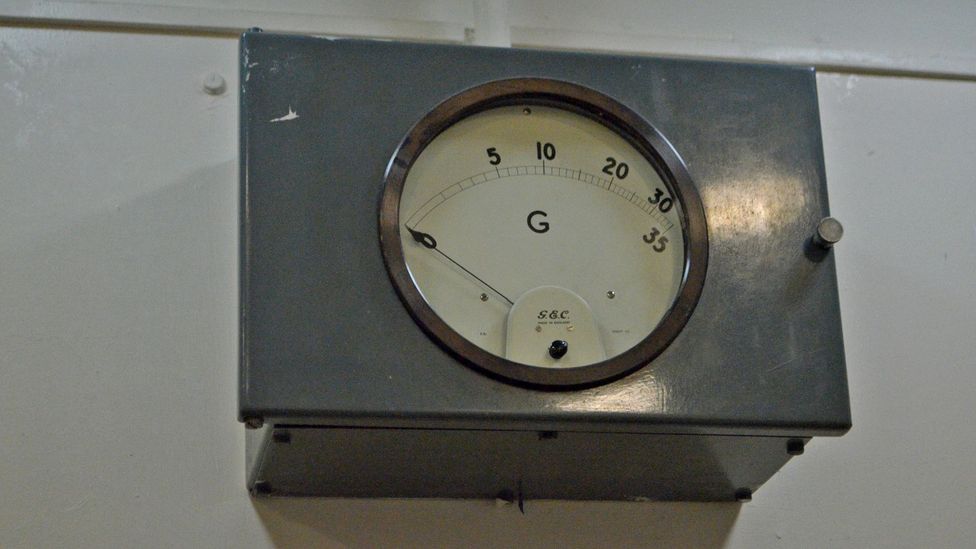
A dial in the control room shows the maximum G the device is capable of recreating (Credit: John Watkins)
When the controller hits the beginning push button – and it is a proper, old-school, large push – on his retro-way Wink Gordon console, dials flicker, the computer disc rotates and the centrifuge spins.
Fast.
Very, very fast.
This machine was designed to simulate accelerations for pilots and fifty-fifty astronauts, when it was thought (or perhaps hoped) that U.k. would develop its own astronaut programme. Mid-1950s rocket designs suggested that extreme accelerations would be needed to achieve orbit. As a result the K-force meter on the wall goes upwards to 35G – although information technology was shortly realised that no human would be able to suffer such extreme forces. These days the maximum allowed is 9G.
The tech may be mid 20th Century simply the experiments are still beingness used to test the latest avionics and space equipment.
"Despite the fact information technology's lx years old, this year information technology's probably going to be used more any previous twelvemonth," says Connolly.
Also as investigating the performance of the latest anti-thousand trousers, current experiments include studies of night vision goggles and how specific exercises might aid prevent back and neck injuries under loftier G forces. Another concern is the effect of prolonged acceleration on the lungs.
"The lowermost parts of the lungs tend to collapse under high-m levels when you're breathing loftier concentrations of oxygen," says Connolly. "Pilots are reporting coughs and pain behind the breast os and it might mean a tendency towards oxygen deficiency during flight."
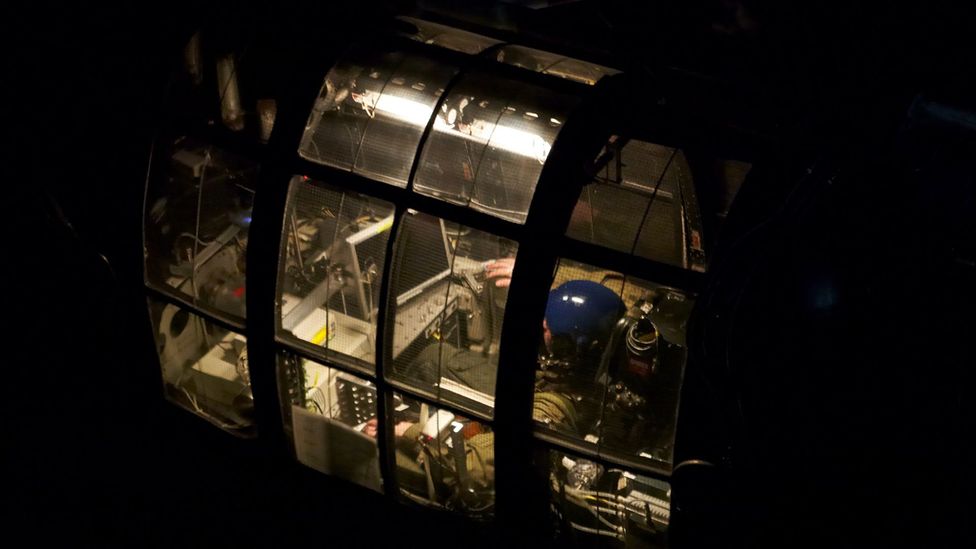
Subjects are strapped into the gondola before it starts to spin (Credit: Qinetiq)
Unlike a modernistic centrifuge, the Farnborough motorcar is also versatile. Although most of the current work involves war machine aircraft, the gondola can be reconfigured to simulate the accelerations of spaceflight. Several space tourists have already trained in the machine and QinetiQ hopes to win more customers as the industry develops.
After a few test runs, we are nearing the climax of the experiment. The centrifuge acceleration builds until the volunteer is put through a simulated combat manoeuvre.
"Stand by, 9G to outset…," says the controller.
'Busiest yr'
Nosotros hear Martin's heavy breathing rasping through a 1950s era wooden loudspeaker as the centrifuge spins, like a Catherine Wheel, in the darkness beneath u.s.a. pushing at the limits of human endurance.
"I'm feeling pretty good," claims Martin when it's all over. "It was fun."
Martin survives and the new techno trousers seem to perform well. That must count as a effect.
With sixty years on the clock, this technological relic from before the dawn of the space historic period seems probable to last well into the era of electronic warfare and commercial space exploration.
"This is the busiest twelvemonth in the centrifuge'due south history," says Connolly, "so we don't meet information technology condign redundant someday soon."
Follow uson Facebook , Twitter , Google+ , LinkedIn and Instagram.
Belum ada Komentar untuk "How Astronauts Train Their Lungs for Space Travel"
Posting Komentar